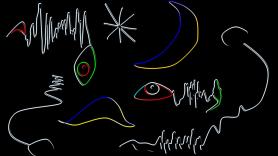4. Sleep and big data
“To what extent do our genes determine how we sleep?” This is the basic question in the studies presented by Simon Warby, professor at the University of Montréal. “Before, the most complicated thing was analyzing DNA, but now that’s the simplest part,” he ensured. Sleep patterns are highly stable in each individual, and studies with twins have shown that they are highly hereditary, as well.
Big data in genetics tends to be called genomics. Studies with huge amounts of data have drawn links between various genes and narcolepsy (making it compatible with the theory that its origin is autoimmune), restless leg syndrome and chronic insomnia. This “not only opens the door to new treatments, but also to the possibility of using inverse genetic approaches, studies that discover new functions of genes and the basic biology of sleep,” Warby summed up.
Studies with big data have also allowed scientists at the IRBLleida to analyze the whole population of Catalonia treated with continuous positive pressure for sleep apnea, which means looking at the data for more than 70,000 people. By analyzing their clinical history and comparing it to more than 180,000 control subjects (people without apnea), researchers observed, surprisingly, that men undergoing treatment had a lower mortality rate than men without apnea (although in women, the opposite seemed to be true). Although more studies need to be done, Sandra Bertran, a statistician at IRBLleida, defended the use of these approaches, which aren’t your run-of-the-mill clinical trials but, given the amount of data included, can be very powerful tools for testing a hypothesis.
Another way to use big data in sleep studies is with portable devices (wearables). This is what the cronobiology group led by Maria dels Àngels Rol at the University of Múrcia is doing, with devices that measure temperature, activity and, even, exposure to different types of light (blue, yellow and red). Social media is also a good source of big data. For Mark Aloia, vice president for Behavior Change at Philips, this is a great opportunity to spread healthy messages. “Facebook users already make up one third of the global population and many are concerned about their health,” he said. “But that is easier said than done: most people who have portable device data are more concerned with monetizing it than with improving sleep patterns of the general population.”
To try to influence and improve this, a new project in the city of Vitoria has just kicked off with collaboration from IRBLleida. Taking into account that between 10% and 35% of the population sleeps fewer than six hours, and that this has a direct effect on mortality, they have developed “a mobile app and platform to collect sleep data from residents and send them information with personalized recommendations,” explained Carlos Egea, head of the Sleep Department at the Araba University Hospital. For Ferran Barbé, “This is a star project. We have to create sleep-friendly cities and environments,” he said.



